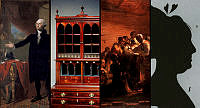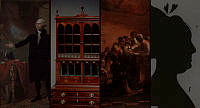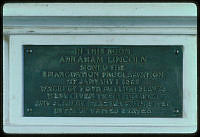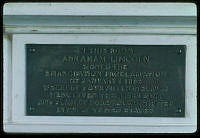Rubenstein Center Scholarship
The First Baptist Church of the City of Washington, D.C.
This article is part of the Slavery in the President’s Neighborhood initiative. Explore the Timeline
The First Baptist Church of the City of Washington D.C. was founded in 1802, shortly after Washington D.C. became the federal seat of government.1 For Baptists in early America, religious liberty was a pillar of the faith, but one that did not fully extend to enslaved persons and free Black people within Baptist congregations. As a church just north of the President’s Neighborhood, the history of First Baptist exemplifies a complicated relationship between religion and slavery in the nation’s capital, and highlights the experiences of enslaved persons and free Black people who sought to practice their religion in the face of slavery and segregation. Today, First Baptist continues to worship on the corner of Sixteenth and O Streets N.W.
On July 5, 1801, a group of Baptists met in the Treasury Building for a preaching service led by Rev. Lewis Richards of Baltimore. Eight months later, the First Baptist Church was organized with six founding members on March 7, 1802.2 The church began meeting in a private home and later that year a meeting house was built on the corner of Nineteenth and I Streets N.W. In May of 1807, Rev. Obadiah Bruen Brown was called to be the church’s first full-time pastor.3 Brown had previously preached at a church in Salem, New Jersey and was twenty-eight years old when he became the pastor of First Baptist.4
OBADIAH BRUEN BROWN
Brown served as pastor of First Baptist from 1807 until his retirement in 1850. As was common with early Baptist churches, Brown conducted his ministry without receiving financial compensation from the church. For income, Brown worked for the U.S. Post Office, ultimately becoming chief clerk to Postmaster Generals William T. Barry (1829-1835) and Amos Kendall (1835-1837) during the presidency of Andrew Jackson (1829-1837).5 In 1821, Brown built a large house at 814 E Street N.W. to use as his family home and boarding house.6 Brown twice served as chaplain of the House of Representatives, from 1807 to 1809 and from 1814 to 1815, and as chaplain of the Senate from 1809-1810.7 Around 1822, Brown served as the director of the Bank of the Metropolis. During the late 1810s, Brown was influential in establishing Columbian College (what eventually became George Washington University) along with Luther Rice and Enoch Reynolds, who were both members of Brown’s congregation at First Baptist.8 Brown was one of three campaigners for the building fund, which received donations from President James Monroe and Secretary of State John Quincy Adams among others. Brown also served as the first President of the college’s Board of Trustees. When Columbian College celebrated its first commencement on December 15, 1824, President Monroe and his cabinet were in attendance for the ceremony, along with the visiting French hero Marquis de Lafayette and other dignitaries. Following the event, Brown attended a reception at the home of William Winston Seaton where Lafayette was the guest of honor.9

This image depicts Rev. Obadiah Bruen Brown, the first full-time pastor of First Baptist. Brown served as pastor of the church from 1807-1850. All images are used with the permission of First Baptist Church of the City of Washington D.C.
Brown’s social and political connections certainly made him an influential citizen of the District. However, the ways in which Brown leveraged those connections on behalf of the enslaved and free Black members of his church remains unclear. By 1818, Brown was involved with the American Colonization Society (ACS), a group formed to send free African Americans to Africa. The emigration policy of the ACS created an eclectic organization of abolitionists, slave holders, free Black people, evangelicals, and white people who wished to rid the United States of its Black population.10 While the precise motivations behind Brown’s involvement with the ACS are undeterminable, he did support missionary efforts linked to the organization. At a meeting of Baptists in 1819, Brown lobbied on behalf of Lott Carey and Colin Teague, two free Black men who requested to be sent to Sierra Leone as missionaries.11
Brown’s attitudes toward the institution of slavery are better understood by his role as an enslaver. Throughout his time in Washington, Brown enslaved at least six individuals. By 1830, Brown enslaved four people, including a mother and daughter purchased from James Roche of Charles County, Virginia. According to the bill of sale, Roche sold Sally (age 30) and Kitty Bell (age 3), to Brown. The bill of sale also included specific references to Simon Bell, husband to Sally and father of Kitty, and General John P. Van Ness, Simon’s enslaver.12 General Van Ness was living in Washington at the time, and became Mayor of the city in 1830. Brown’s purchase may have been partially motivated by a desire to reunite the family in Washington; however, later census records strongly indicate that Brown continued to enslave Kitty for another twenty years after the purchase.13 According to the 1840 census, Brown was the enslaver of a female aged ten to twenty-three. In 1850, Brown was the enslaver of a twenty-four-year-old woman. Kitty would have been fourteen years old in 1840, and twenty-four years old in 1850, suggesting that she was the woman listed in both censuses. If reuniting the family was part of Brown’s motivation for the purchase, the reunion was limited to the same city and did not extend to the same household. Census data from several decades also suggests that Brown did not hold older enslaved people beyond a certain adult age (somewhere between twenty-five and forty-five years old). What happened to these enslaved people, whether they purchased their freedom or were sold or emancipated by Brown, is unknown.

This sketch depicts the house of Obadiah Brown at 814 E Street N.W. The house was erected in 1821 and used by Brown as a family home and boarding house. Members of Congress including Representatives John T. Johnson (KY) and Ambrose H. Sevier (AK) and Senator Richard M. Johnson (KY) boarded at this house. All sketches were drawn from old church photographs by Marian Alexander Jones and all images are used with the permission of First Baptist Church of the City of Washington D.C.
First Baptist Church of the City of Washington D.C.ENSLAVED PERSONS AND FREE BLACK PEOPLE AT FIRST BAPTIST
Enslaved persons made up a significant portion of First Baptist’s membership during the antebellum period. When enslaved individuals joined the church, their race, status, and slave owner’s name was included in the record. In many cases, the slave owners identified in the membership records of enslaved persons were themselves members of First Baptist, though a number of enslaved persons joined the church of their own volition. On May 9, 1819, an enslaved woman named Susan and identified as a “Servant of President Monroe” joined the church.14 At the time Susan joined, President Monroe was living in the rebuilt White House; however, while serving as Secretary of State under President James Madison and at the beginning of his presidency, President Monroe lived down the street from First Baptist at Caldwell House on 2017 I Street.15 Monroe supported Brown in establishing Columbian College and the two likely had a working relationship. The connection between President Monroe and Pastor Brown possibly contributed to Susan’s decision; yet, as President Monroe was not a member of First Baptist, Susan’s decision to join the church was likely her own. Click here to learn more about the enslaved households of President James Monroe.
Free Black people also comprised a sizeable portion of First Baptist’s membership. Much like enslaved persons, free Black individuals were identified by their race and status in church records. One prominent free Black family to join First Baptist were the Wormleys. Mary and Lynch Wormley moved to Washington in 1814 from Albemarle County, Virginia, where they had lived adjacent to the Coles family, which included Sarah Coles, the cousin of Dolley Madison. Mary joined the church in 1818, while Lynch did not join until 1839. The Wormleys’ son, James (the founder of the famous Wormley Hotel near Lafayette Square), also joined the church and was married by Brown in 1841. Click here to learn more about Mary and Lynch Wormley.
Paul Jennings also joined First Baptist as a free Black man, though he was still enslaved at the time of his original petition for membership. Jennings was born on the estate of James and Dolley Madison in 1799. During Madison’s presidency, Jennings worked as a valet and dining room servant in the President’s House.16 In early 1846, while still enslaved by Dolley Madison, Jennings requested to join First Baptist but was denied membership due to what the church perceived to be a lack of repentance of sin. The committee that reviewed Jennings’ petition for membership reported that “The outward conduct of Paul is represented as being correct, but the committee are not satisfied that he has yet become thoroughly sensible of the nature and magnitude of his sin, not experienced true evangelical repentance.”17 Consideration for Jennings’ acceptance appears to have remained open, however. In September of 1846, Dolley Madison sold Jennings to local insurance agent Pollard Webb. About six months later, Massachusetts Senator Daniel Webster purchased Jennings’ freedom. Jennings agreed to work for Webster until the financial cost of his freedom was paid. During this period, Jennings was involved in organizing an attempted escape of enslaved persons on board The Pearl in April 1848, though Jennings never boarded the vessel himself. Six months later, on December 8, 1848, Jennings was accepted as a member of First Baptist. While a perceived lack of repentance had delayed Jennings’ acceptance, his involvement with an attempted escape of enslaved persons appears to have had no bearing on the committee’s decision. Click here to learn more about Paul Jennings.

Church minutes from December 8, 1848 record the acceptance of Paul Jennings as a member of First Baptist. Jennings applied to join the church in 1846 while enslaved to Dolley Madison, and had his membership delayed for over two years because the church did not believe he was thoroughly repentant. By the time Jennings was formally accepted into the church he was a free man, having paid off a debt to Senator Daniel Webster who purchased Jennings’ freedom. Images from minute book were taken by the author and all images are used with the permission of First Baptist Church of the City of Washington D.C.
First Baptist Church of the City of Washington, D.C.Throughout the antebellum period Black people, both enslaved and free, found a religious home at First Baptist. The first African American to join First Baptist was Rhoday Hampton in 1803.18 By 1810, African Americans comprised approximately thirty percent of total membership. As the church grew over the next three decades, African American membership increased at a faster rate than white membership, and by 1840 134 African Americans were members of First Baptist, approximately forty-five percent of the church’s membership.19 The increase in African-American membership, particularly among enslaved persons who joined independently of slave owners and free Black individuals, suggests that First Baptist became a viable church option for African Americans. Both enslaved persons and free Black people were included as full voting members in all church matters. When an 1832 a proposal would have allowed only white members to vote on financial issues, the church’s African-American members opposed the decision and “after considerable discussion on the subject, it was disagreed to, the Colored members voting against it.”20
First Baptist also encouraged literacy amongst its membership, establishing a Sabbath School in 1819 that included African-American members despite opposition from the Baltimore Baptist Association of which First Baptist was a member.21 There also appears to have been an early effort in the church to encourage white slave owning members to manumit their enslaved persons, contingent upon the enslaved person covering the cost of manumission. In 1817, a complaint was made against Samuel Smoot for selling two of his enslaved persons “contrary to his voluntary stipulation with the church to emancipate them, after they should serve him a reasonable time to remunerate him of their cost and expenses.”22 After reviewing the case, the church unanimously voted to exclude Smoot from the church, a punishment that Smoot agreed was fair.23 No other cases were brought forth, and if manumission was encouraged at First Baptist it does not appear to have been widely effective or aggressively pursued.
LIMITATIONS ON BLACK MEMBERSHIP AND SEPARATION
Despite the inclusion of African Americans at First Baptist, the church still reflected many of the same racial prejudices of the time. During services, separate seating was designated for African Americans in galleries at the back of the church. As the church grew in the early 1820s, the galleries were extended to seat the growing number of African-American members. Some members even proposed altering the stairway to the entrance of the church to provide a separate outside entry to the galleries, though this alteration was never implemented.24 While African Americans were allowed to vote on church matters, they were excluded from holding leadership roles within the church. These restrictions almost certainly encouraged racial tensions between white and Black church members. In December of 1817, possibly following a failed effort to encourage manumission, Rhoday Hampton was designated by the church as a leader among First Baptist’s African-American members. According to Brown, who recommended the appointment, Hampton had been instrumental in “reconciling some differences among the colored brethren.”25 Hampton served as a mediator when conflict arose between First Baptist’s African-American members. By 1830, a group of African-American members began meeting separately from the larger congregation in a rented school room separate of the church, with the exception of Communion Sundays when they joined with the larger church for services. Upon hearing a report from African-American member Jean Pierre, who helped rent the school room, the church offered no protest against the separate meetings.26

This sketch depicts the original First Baptist Church located at the corner of I and Nineteenth Streets N.W. When the church moved to Tenth Street in 1834, many of First Baptist’s African American members chose to remain at the original church. In 1839, the Nineteenth Street Church became the First Colored Baptist Church, the first Black Baptist Church in Washington D.C. All sketches were drawn from old church photographs by Marian Alexander Jones and all images are used with the permission of First Baptist Church of the City of Washington D.C.
First Baptist Church of the City of Washington, D.C.The most consequential division between white and Black members at First Baptist came in 1834 with the construction of a new church building on Tenth Street, at the future site of Ford’s Theatre. First Baptist’s continued growth in membership necessitated a larger meeting house and they wanted to select a site at the center of the city. As Washington D.C. grew during the early decades of the nineteenth century, the city’s center developed southeast of First Baptist, around the Capitol Hill area. Brown had moved to E Street N.W. in 1821, two blocks from where the new church was ultimately constructed.27 Wealthier members of the church supported a new location at the center of the city, but many of First Baptist’s poorer members, including enslaved persons, preferred the church to remain in its original location.28 Deciding that two locations would be advantageous, the church moved forward with the new building, which opened in 1834, but maintained ownership of the original Nineteenth Street building. The decision, which likely began as an effort to maintain a church presence in both areas of town, soon led to two separate congregations, with the Nineteenth Street church becoming exclusively African American. White members, along with many free Black members and those enslaved by white members, started attending the Tenth Street church. Other enslaved persons and some free Black individuals chose to remain at the Nineteenth Street church. By November of 1838, thirty-two African-American members formally requested to separate from First Baptist to “be constituted a church of Jesus Christ in this City.”29 The new church would worship in the Nineteenth Street building independent of the Tenth Street church. A number of African-American members opposed the separation, drafting a letter to the church that read in part:
“We are satisfied that in our present situation we enjoy as high privileges as our Heavenly Father sees good for us to enjoy, and that it will be better for us and for the cause of Christ to have the fellowship and counsel of our white brethren in Church matters than to forego them by separation; and as we are not aware of any cause why we should separate nor of any benefit which will be likely to result from the measure, we desire to retain our standing in the Church to which we now belong, and not to be considered as among those who desire to withdraw.”30

Early church membership was recorded in the back of First Baptist’s book of minutes (1802-1845). Entries include the name, date, and manner in which a person joined the church. For African American members, race was also identified. For enslaved persons who joined the church, their status was identified as “servant” and their enslaver was included in the entry. Images from minute book were taken by the author and all images are used with the permission of First Baptist Church of the City of Washington D.C.
First Baptist Church of the City of Washington, D.C.The letter was signed by nineteen African-American members. When the members who desired to separate presented their request to the church, an additional eleven names were added in opposition to the letter’s request.31 With thirty-two members wishing to separate and approximately thirty others voicing opposition, African Americans at First Baptist were fairly evenly divided on the issue.32 Ultimately, the members of First Baptist voted to allow the separation but retained ownership of the Nineteenth Street property until 1875.33 On August 29, 1839, the First Colored Baptist Church of Washington (now Nineteenth Street Baptist Church) was established at the Nineteenth Street church.34 At First Colored Baptist, members were able to serve in leadership roles, sit where they pleased during services, and exercise greater control over the church where they worshipped, liberties that were not afforded to Black members of First Baptist.
The formation of a Black Baptist church in the city greatly impacted First Baptist’s African-American membership. By 1852, only forty-four African Americans were listed as members of First Baptist, compared to over 100 members in the 1830s. Still, of the forty-four members listed, twenty-one joined the church after the formation of First Colored Baptist, including both enslaved persons and free Black people. For some, like Paul Jennings who joined in 1848, the social and political influence of First Baptist may have influenced the decision to stay with the segregated church.

This sketch depicts First Baptist’s second meeting house located on Tenth Street N.W. Many of First Baptist’s white and free Black members began worshipping in the new church when it was completed in 1834. In 1861, after moving to a third meeting house, First Baptist sold the building to John T. Ford who turned the meeting house into a theatre. All sketches were drawn from old church photographs by Marian Alexander Jones and all images are used with the permission of First Baptist Church of the City of Washington D.C.
First Baptist Church of the City of Washington, D.C.CONCLUSION: DIFFERING BLACK EXPERIENCES
The history of First Baptist and the experiences of the church’s enslaved and free Black members underscore the precarious position of African Americans in the President’s Neighborhood. For enslaved persons and free Black people who joined First Baptist, the church offered a semi-integrated religious community and an essential social network for African Americans forced to navigate the hazards of a slave society. A relationship with the influential Obadiah Brown and other prominent church members could have provided social and economic advantages or opportunities, particularly for free Black members like the Wormleys and Paul Jennings. The reluctance by some African American members to separate from First Baptist and the continued membership of free Black people after the formation of First Colored Baptist at the very least indicates a perceived advantage of remaining with the church. Additionally, separating from the church’s white membership was a risky endeavor. As late as 1862, Washington’s Slavery Code placed restriction on enslaved persons and free Black people, including a prohibition against African-American religious groups meeting after ten o’clock in the evening.35 Conversely, remaining at First Baptist ensured continued segregation and unequal treatment for African Americans. Membership for enslaved and free Black people did not mean equal standing within the church, where African Americans were confined to segregated galleries during services and likely had limited say in church matters that didn’t require a vote or congregational approval. Whatever social or political benefits a relationship with Brown and others may have provided African American members did not negate the realities of worshipping in a congregation composed of and led by enslavers.

Susan, identified as a servant of President Monroe, joined First Baptist on May 9, 1819. Enslaved people like Susan chose to join First Baptist when the church was located on Nineteenth Street and made up a significant percentage of the church’s membership. Images from minute book were taken by the author and all images are used with the permission of First Baptist Church of the City of Washington D.C.
First Baptist Church of the City of Washington, D.C.The decisions made by enslaved persons and free Black members certainly varied. Many enslaved persons were not afforded the opportunity to decide between remaining a part of First Baptist or separating to meet exclusively with other African Americans. Enslaved persons owned by white slaveholding members may have been prohibited from leaving the church. Furthermore, after the move from Nineteenth Street, enslaved persons who joined independently of their enslavers were almost certainly unable to travel to Tenth Street for services. Free Black people who had enough autonomy to decide where they wanted to worship were able to make the calculation between the advantages of associating with First Baptist and the independence that came with worshipping in the Black church. While many remained with First Baptist, records indicate that the majority of enslaved persons and free Black people, when given the choice, preferred to pursue autonomy and freedom rather than to remain in an integrated yet segregated church.
Thank you to Janice Osborn and Ellen Parkhurt for their research assistance and insight.
About the Author
Kristofer Roberts is a Ph.D. Candidate in history at the University of Alabama. His research interests include nineteenth-century America, religious history, and African American history. He received his B.A. from Samford University and a Master of Divinity from the Chandler School of Theology at Emory University.





